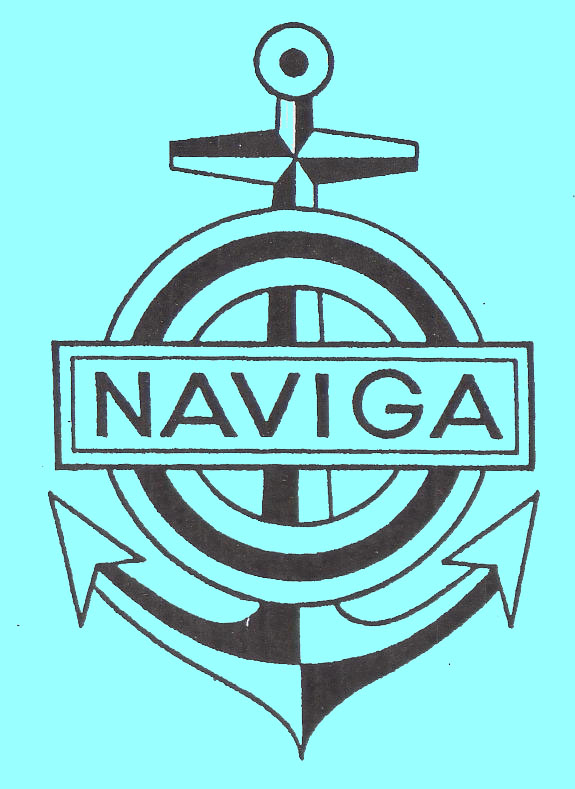
|
|
|
|
2003
|
|
FSR-H/V
|
| Issued by the FSR Section of Naviga |
| in February 2003 |
|
World Organisation for Model shipbuilding and Model ship sport Weltorganisation für Schiffsmodellbau und Schiffsmodellsport Organisation Mondaile de Navimodelisme et de Sport Nautique |
|
NAVIGA - Competition Rules 2003 Categories FSR - H/V |
|
The NAVIGA - Competition rules of 2003 for the categories FSR-H and FSR-V have been
updated based on the NAVIGA - 1997 Competition Rules, and the decisions during the General meeting in 2002 Amendments, additions and proposals for improvements are to be directed to the NAVIGA Section Management via the representative of the country. In case of doubt of the interpretation of the Rules and Regulations the English text will prevail. |
| The NAVIGA Executive Committee |
|
CONTENTS:
|
|
3.1.1. Competitions where the rules apply 3.1.2. Entry fees 3.1.3. Protest fees 3.2.1. Age Groups 3.2.2. Competitors registration 3.2.3. Maximum allowed number of competitors 3.2.4. Assistant and substitution of the competitor 3.3.1 Propulsion of models and propulsion agents (fuel) 3.3.2 Fuels 3.3.3 Noise reduction, noise level measurement and rules 3.3.4 Application and use of radio control equipment and frequency control 3.3.5 Time measuring 3.3.6 Buoys (dimensions, construction, anchorage) 3.3.7 Starting pontoon (construction and materials) 3.4.1. The competition area 3.4.2. Starting area, preparation area and access permission 3.4.3. Allowed number, entries and condition of models 3.4.4. Re-run of a race 3.4.5. Registration numbers 3.4.6. Registration of competitors and models 3.4.7. Issuing of starting permits, issuing start and computer passes 3.4.8. Surrender of competitor passes and assessment of running order 3.4.9. Calling time (time allowed to get ready) 3.4.10. Preparation times (at the starting point) 3.4.11. Interruption / Suspension of the competition 3.4.12. Scoring and announcement of the results 3.4.13. Checking of the first three placed models during World and Continental Championships 3.4.14. Awarding of titles at World and Continental Championships 3.4.15. Award ceremonies at World and Continental Championships 3.4.16. Result lists 3.5.1 Principal rules 3.5.2 Lodging of protests 3.5.3 Handling of protests
6.2 Manning level of the start pontoon 6.3 Minimum requirements for the starting area 6.4 Competition course and race duration in FSR-V classes 6.5 Procedure for races in the FSR-V classes 6.6 Lap counting for FSR-V races 6.6.1 Manual lap counting 6.6.2 Computerised lap counting 6.7 Scoring in FSR-V classes 6.8 Composition of result lists in the FSR-V classes 6.9 Competition course and race duration in the FSR-H classes 6.10 Start clock for FSR-H classes 6.11 Procedure for races in the FSR- H classes 6.12 Basic rules and penalties in the FSR - H classes 6.12.1 Left turns 6.12.2 Right of way 6.12.3 Negotiating / passing the buoys 6.13 Rules for overtaking in the FSR-H classes 6.14 Calculation of final results in FSR-H classes 6.15 Composition of result lists in the FSR-H classes 7.1 General 7.2 Measuring methods in FSR-H 7.3 Measuring methods in FSR-V APPENDIX
Guide to measuring and setting up a FSR-V course
|
|
Competition rules for radio controlled models in categories FSR-H and FSR-V
|
1. Definition of models Models in the FSR categories are controlled by the competitor using radio control. These are model boats of free design, which conform to the race requirements,however should in form and design look like a boat. 2. Classes The category FSR can be divided into the following groups and classes: Class FSR-H3.5 Class FSR-H3.5 Free build HYDRO - planes* with internal combustion motor up to 3.5 cm3 and with surface drive propulsion. Class FSR-H7.5 Free build HYDRO - planes* with internal combustion motor above 3.5 cm3 up to 7.5 cm3 and with surface drive propulsion. Class FSR- H15 Free build HYDRO - planes* with internal combustion motor above 7.5 cm3 up to 15. cm3 and with surface drive propulsion. Class FSR-V3.5 Free build racing models for endurance races (20 – 30 min) with internal combustion motors up to 3.5 cm3 and below waterline propulsion. Class FSR-V7.5 Free build racing models for endurance races (20 – 30 min) with internal combustion motors above 3.5 up to 7.5 cm3 and below waterline propulsion. Class FSR-V15 Free build racing models for endurance races (20 – 30 min) with internal combustion motors above 7.5 up to 15.0 cm3 and below waterline propulsion. Class FSR-V35 Free build racing models for endurance races (20 – 30 min) with internal combustion motors (petrol-motor with spark plug ignition) above 15.0 up to 35.0 cm3 and below waterline propulsion. Remark: * HYDRO-planes (A free build model with two or more planning surfaces). |
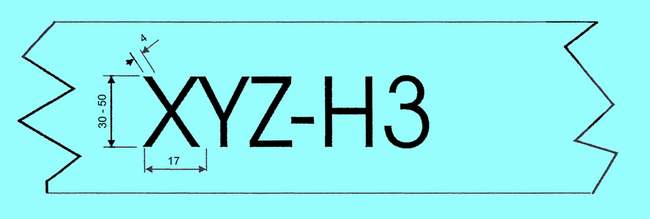
|
Drawing 1 Registration number
3.4.6 Registration of competitors and models
(1) Each competitor is required to register their models including any
spare models and their radio control equipment, within the
registration time announced.
(2) Together with the models, the competitor must show the confirmation
of their registration issued by the organisers. Group confirmation
should be shown by the team leader.
(3) Qualified judges should be appointed by the organisers to carry out
registration. These have to be confirmed by the jury of race officials.
(4) The registration must be arranged by the organisers so that it can be
completed within the set period, ensuring the planned start of the
race and minimum disruption to competitors. According to the number
of registered competitors and models, marked registration areas for
various classes should be arranged.
The organisers must appoint sufficient qualified assistants.
(5) The competitors must show their model for registration in the
condition, in which it will be used in the race.
(6) The following items must be included in the registration list:
- Surname, Christian name of the competitor and their nationality
- Class
- Registration number
- Specification of the radio equipment (frequency, modulation,
working frequency, spare crystals)
(7) A marking on an appropriate place on the hull (shield, sticker,
stamp or similar) must be affixed to each registered model.
The marking should not leave permanent stains on the outside
of the model.
|
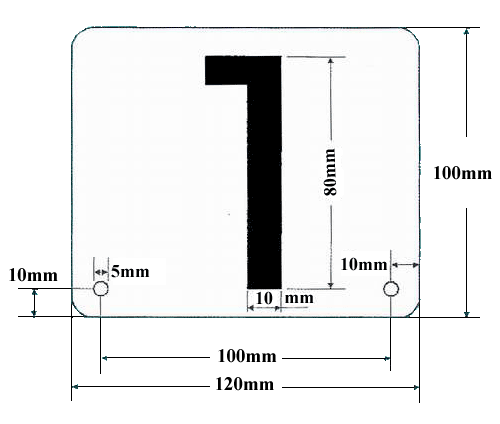
|
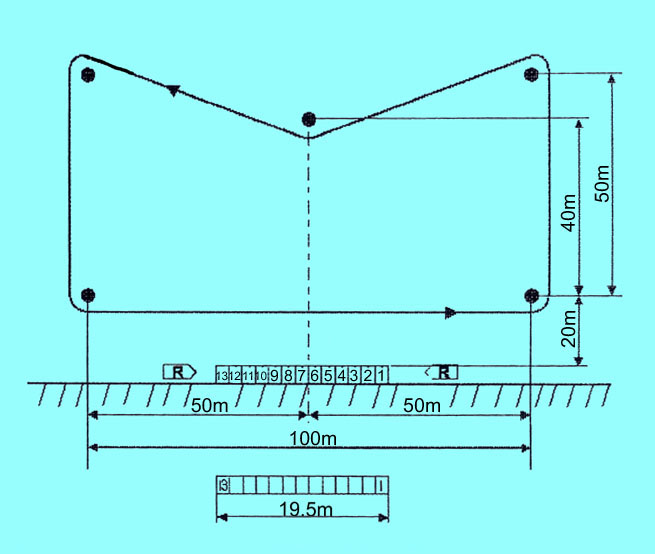
|
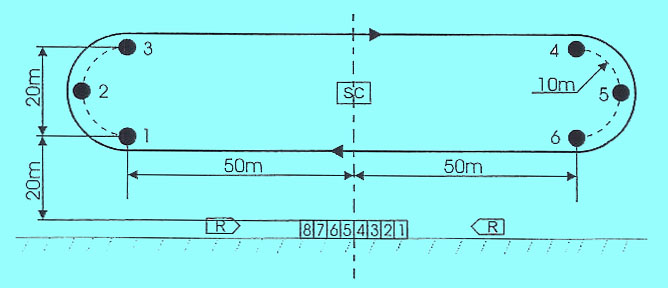
|
--------- = Start and finish line
8……1 = Start positions
RB = Rescue boat
SC = Start clock
Drawing 4: FSR - H competition course
(2) The models have to achieve the following number of laps within 4 minutes:
FSR-H3.5 =5 laps
FSR-H7.5 =6 laps
FSR-H15 = 7 laps
(3) Starting time for the heat has to be shown on a start clock (see drawing 5)
or other adequate (optical or acoustic) means.
6.10 Start clock for FSR-H classes
(1) The start clock is designed for FSR-H races with special optical and
acoustical information and signals which the competitors use to prepare
for the start of the heat.
|
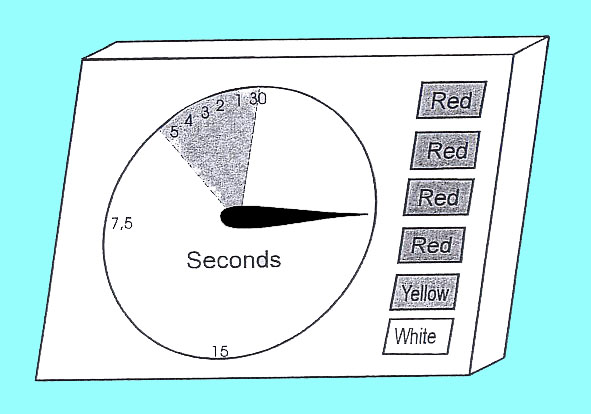
|
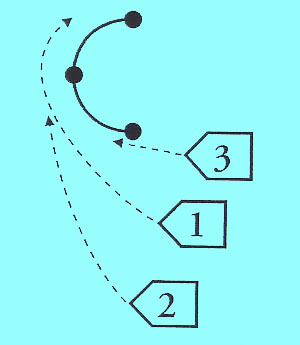
|
Example No. 2 |

|
Example No. 3 |
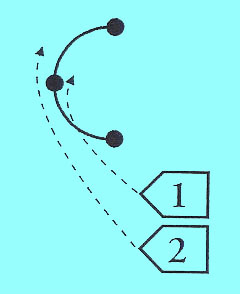
|
Example No. 4 |

|
Example No. 5 |

|
6.14 Calculation of final results in the FSR-H classes
(1) In FSR-H classes, each competitor receives the following
points according to the place achieved:
1. Place = 400 points
2. Place = 300 points
3. Place = 225 points
4. Place = 169 points
5. Place = 127 points
6. Place = 96 points
7. Place = 72 points
8. Place = 54 points
Race not completed = 25 points
Boat did not pass the starting line after the starting
signal = No points
(2) In cases of equal points there should be a run off
in the following cases:
a) To select a competitor for the final.
b) In the final, to decide places 1, 2 or 3
The run off will be held after the completion of
the heats or after the finals.
(3) The final result of the competition is the sum of all
points achieved in all heats, unless finals are held.
(4) If a final takes place, the results will be as follows:
a) All the finalists are placed according to the total
of points achieved during the final.
b) The remaining competitors are placed according to
the total of points achieved during the
qualification heats.
|
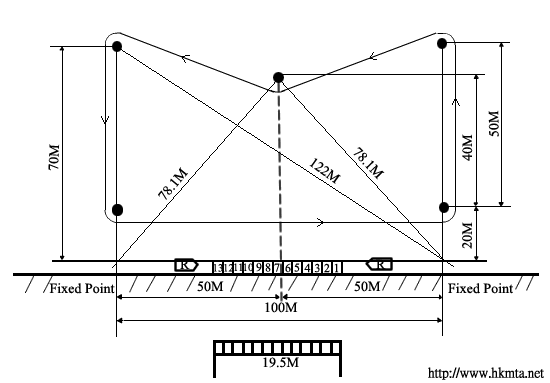
|